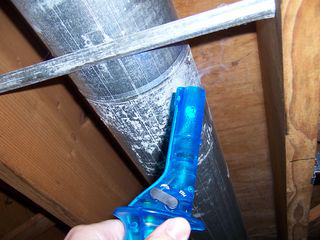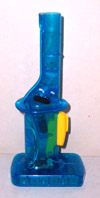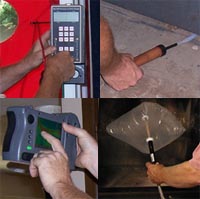
by blogediter | Mar 19, 2018 | Save Energy
Smoke Puffer
My smoke puffer has stopped working. The batteries are fresh and the unit has full fluid. The light does come on when the trigger is pulled. I am using a fresh set of regular Energizer batteries. (I’ve tried another set thinking it may be weak batteries but it isn’t.)
I’m not sure if the internal parts are bad. Are there replacement parts for the device? I use it every day for my energy audits. I’ve been using mine for about 6 months. It’s the best tool on the market for the draft testing smoke. – WA
A: Dear WA,
It sounds like the heating element in the Smoke Pencil took one jolt too many. We highly recommend rechargeable batteries to use with your Smoke Pencil, because alkaline batteries tend to create power spikes at the start and end of their power cycles (every time you pull the smoke trigger). These voltage jolts tend to be hard on the small heating element in the smoke pencil and eventually wear it down over a long periods of time (like 6 months). Rechargeable batteries, on the other hand, keep a nice steady voltage and don’t spike, so they are not hard on the Smoke Pencil and they can help it last many times longer.
I would really recommend rechargeable batteries for your Smoke Pencil, especially since you use it every day. We sell a rechargeable kit on our website www.smokepencil.com but to be honest you can use any AA rechargeable. This advice is too late for your current Smoke Pencil, but I tell you what, if you call in an order and ask for me, I will make sure you get free shipping on your next one. – Jason

by blogediter | Feb 26, 2018 | Save Energy
Smoke Pencils
Q: Jason, How long can I expect the 3oz bottle of Smoke fluid that comes with the Smoke Pencil last me? Can I buy additional smoke fluid for the smoke pencil puffer, and if so, what is the link for that? Thanks, -TW
A: TW, When using the Smoke Pencil lightly depress the trigger for about 5 seconds and make a nice small trail of smoke that will linger for about 30 seconds. this works well if you are testing door weatherstripping or window seals. If you use the Smoke Pencil in this manner you can keep the smoke generating for hours and hours and not even use a full ounce.
What really uses up the smoke fluid quickly is if you are making a big puff of smoke with the Smoke Pencil. Say you hold the trigger down for a minute and hit the puffer trigger a few times to make a nice big plume of thick smoke. You may want to make a big plume of smoke like this if you are testing the draft of a large fireplace. If you do this 3 times you may use about a 1/10th of an ounce which is about the amount the reservoir tank on the Smoke Pencil will hold. So even if you are making big plumes of smoke you may use it 100 times before you need more smoke fluid. – Jason

by blogediter | Feb 23, 2018 | Save Energy
Smoke Pencil Puffer
Test Weather Stripping
In my opinion, a smoke pencil puffer is a tool that any home handyman should have in his toolbox. When working on energy saving home improvements like window & door installs, weatherstripping, duct sealing, insulation, and other air sealing projects they are such a helpful tool. You do your improvement, and then use the little trace of smoke generated from the smoke stick to see if you have stopped the air movement in that area.
The Trouble with Smoke Pencils
The trouble is up until this point smoke pencil puffers have been rather expensive ($50 -$75 or more) and most operate on toxic chemical mixes to make the smoke. Because the chemicals used in the traditional smoke stick puffers operate on acid fumes and the smoke they generate is toxic they are not healthy to use in confined areas and if you use them too much they can be bad for your health. Furthermore, if you travel with your tools you cant take an acid-based smoke puffer pencil on a plane in carry-on or checked luggage, and you cant send them in the US Mail since they are considered hazardous material.
New Non-Toxic Smoke Pencils
Fortunately, there is a new Smoke Pencil puffer that I just was introduced to at the affordable comfort Institute Conference in Kansas City. Instead of using acid mixtures to generate smoke this non-toxic smoke pencil puffer uses a harmless liquid mixture and heats it slightly to generate a nice highly visible smoke. The trigger mechanism on this Smoke Pencil allows you to control the amount of smoke you generate. So if you need just a little trickle of smoke to test weatherstripping you lightly depress the trigger. If you are testing a larger area like a door jamb you can hold the trigger down longer and create a nice plume of smoke. I have allergies so I am a bit sensitive to most smoke, but this smoke stick used a mixture of water, propylene glycol, and glycerin that is similar to the smoke generated by toy trains. So using this smoke stick does not bother my allergies at all and the faint sweet smell to the smoke fades fast so there are no lingering odors.
Price of a Smoke Stick
The thing that really sold me on this new smoke puffer pencil is the low price. At $25 this smoke stick was half the price of the cheapest acid based smoke puffers, I was familiar with. So I bought one of these non-toxic Smoke Pencils and brought it home and started testing it. I also gave 2 of them to some energy rater & insulation contractor friends to try out. After testing it, we liked it enough to have it offered on the Chimney Balloon website. So you can buy a smoke pencil puffer at www.ChimneyBalloon.us

by blogediter | Jan 11, 2018 | Save Energy
Saving Home Energy
Here is a list of some free and cheap energy saving ideas that are good advice for summer or winter:
$100 or less ideas
- Roll of Aluminum tape or mastic tape to seal the seams of the heating vents in the attic or basement = $20 for a roll
- Use squares of rigid insulation foam to make a box cover for the attic pull down stairs = $35 worth of foam and glue.
- If you have a drafty window or door pull the molding off to see if there is any insulation around the window jamb gap = $7 for a can of low expansion window foam.
- Use a Chimney draft excluder like a Chimney Balloon or Flueblocker to plug the fireplace to prevent drafts through the damper = $45-$55 per fireplace
- Clean your AC coils. If you don’t want to fork out $100 or more for a professional AC tune-up, at least check your outside compressor and make sure it is clear of weeds, grass clippings and dirt free. Even a clean looking compressor can have a thin film of dirt on its fins, and that is limiting the heat transfer. Buy a can of foaming coil cleaner from the home improvement store and use your garden hose on low pressure to clean the fins. = $7 for a can of coil cleaner.
- Chase down drafts with a DIY energy audit. On a particularly windy day close your home up as tightly as you can. Then use a Smoke Pencil ($35) to check all your windows and doors and plumbing penetrations under your sinks to see if you are taking in air through the cracks. Use foam and caulk to seal them up. Then turn on your AC unit and while it is blowing, go to your attic or crawlspace (wherever your ducts are) and check the ducts with the smoke pencil to see if the joints and seams are leaky ad need more mastic applied.
- If your garage or attic tend to get super-heated, radiant barrier panels can help mitigate this. You can install these reflective panels into your ceiling joist bays in the attic or against your garage door sections to reflect out much of the radiant heat gain that is transferring into your home. They generally cost about $100 for 50 panels, which will cover most moderate sized attics.
Free
- Vacuum out HVAC return vent covers.
- Adjust the dampers on the heating vents to heat the rooms evenly.
- Do not use an open wood or gas log fireplace during cold weather. They tend to suck in more heated air from the home than they provide back.
- Clear the outside dryer vent exhaust flapper of any lint. The flapper should close back up completely when the dryer isn’t running.
- Keep long curtains from covering furnace and A/C vents (you would be surprised how often we see this)
- If you find bent/flattened fins on your AC coil, take the time to carefully use a butter knife to bring them back to straight. This also improves air flow and heat transfer.



